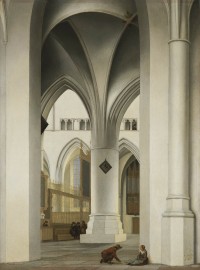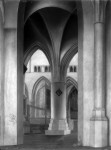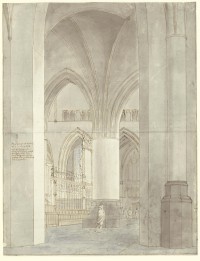 The Choir of the Saint Bavo in Haarlem (1636) by Dutch Golden Age artist Pieter Jansz Saenredam is an architectural perspective of the interior of the Gothic church of Saint Bavo. Known as the portrait painter of Dutch churches, Saenredam’s specialty was capturing the complex geometries and soaring heights of church interiors to convey their light, stillness and grandeur. Saint Bavo was one of his favorite subjects. He made about 30 drawings and 12 paintings of the church.
The Choir of the Saint Bavo in Haarlem (1636) by Dutch Golden Age artist Pieter Jansz Saenredam is an architectural perspective of the interior of the Gothic church of Saint Bavo. Known as the portrait painter of Dutch churches, Saenredam’s specialty was capturing the complex geometries and soaring heights of church interiors to convey their light, stillness and grandeur. Saint Bavo was one of his favorite subjects. He made about 30 drawings and 12 paintings of the church.
Saenredam took a rigorously mathematical approach to his church portraits. He usually made at least two preparatory drawings, one a pencil sketch done freehand in the space to establish the composition, the other a detailed graphite rendition of the scene made with a straight-edge and compass using precise measurements taken of the church by a surveyor.
An exhibition at the National Gallery of Art (NGA) in Washington, D.C., explores how the artists of the Dutch Golden Age employed drawing as part of their painting processes. The exhibition displays almost 100 drawings plus finished paintings by 17th century Dutch masters including Saenredam, Rembrandt van Rijn, Aelbert Cuyp and Jacob van Ruisdael. To prepare for the exhibition, Drawings for Paintings in the Age of Rembrandt, conservators at the NGA examined the paintings with infrared reflectography (IRR) which can reveal underdrawings made with black chalk against a white background. (Red or white chalk underdrawings cannot be detected with IRR.)
 IRR revealed an unexpected surprise in the underdrawing of The Choir of the Saint Bavo in Haarlem: a doodle of a horse carrying four men on its back and a little stick figure in balloon pants underneath them. Drawn on the left pillar in the foreground, the whimsical figures are a marked contrast to the somber whitewashed interior of the post-iconoclasm church. There’s no way Saenredam intended to paint the doodle in the final version, so he must have just been having fun knowing he’d paint over it.
IRR revealed an unexpected surprise in the underdrawing of The Choir of the Saint Bavo in Haarlem: a doodle of a horse carrying four men on its back and a little stick figure in balloon pants underneath them. Drawn on the left pillar in the foreground, the whimsical figures are a marked contrast to the somber whitewashed interior of the post-iconoclasm church. There’s no way Saenredam intended to paint the doodle in the final version, so he must have just been having fun knowing he’d paint over it.
The drawing of four men on horseback is recognizable as a scene from a Charlemagne romance. The oldest extant version of the chanson de geste Quatre Fils Aymon was written in Old French in the 12th century. It recounts the legend of the four sons of Duke Aymon of Dordogne: the chivalric hero Renaud de Montauban and his brothers Guichard, Allard and Richardet. Aymon presents his sons to Charlemagne at a royal tournament with Renaud wins. For his bravery and skill in battle, Charlemagne awards Renaud a magic horse named Bayard. The gift comes in extra handy when Renaud kills one of Charlemagne’s nephews in a fight over a chess game and is forced to flee. Magical Bayard is so big he can carry all four brothers on his back. In the end, the hero Roland convinces Charlemagne to pardon the brothers which he does on condition that Renaud expiate his sins on Crusade.
The Four Sons of Aymon was immensely popular for hundreds of years. Prose versions began to be written in the 14th century in France and the story was translated in multiple languages. The earliest known English version was printed by William Caxton around 1489. The earliest surviving Dutch translation dates to 1508. In this version it’s Duke Aymon who gives Bayard to Renaud and Renaud kills Charlemagne’s son, not his nephew.
 The image of Bayard carrying the four brothers on his back appears in art and sculpture, particularly in northern France, Belgium, the Netherlands and Germany, from the 12th century through the 20th. Not in religious art, though, and certainly not on church pillars. The Bayard doodle conveys the playful side of an artist like Saenredam almost four centuries after he covered it up.
The image of Bayard carrying the four brothers on his back appears in art and sculpture, particularly in northern France, Belgium, the Netherlands and Germany, from the 12th century through the 20th. Not in religious art, though, and certainly not on church pillars. The Bayard doodle conveys the playful side of an artist like Saenredam almost four centuries after he covered it up.
Monday is the last day of the exhibition, so if you’re in D.C. take a long lunch and pop over to the NGA to see the paintings, the IRR images and the related drawings before they move on to the Fondation Custodia in Paris. The rest of us can at least have a little fun sliding between the paintings and their underdrawings as revealed by IRR on the National Gallery of Art’s website.